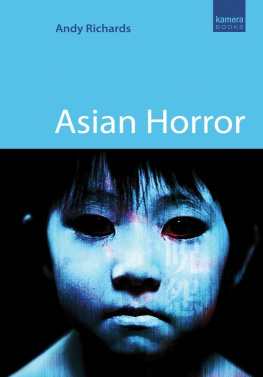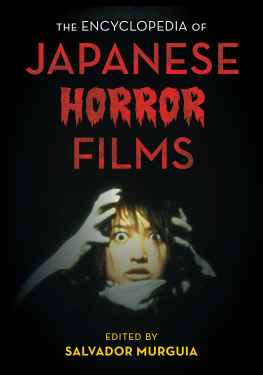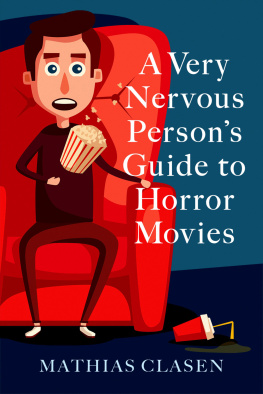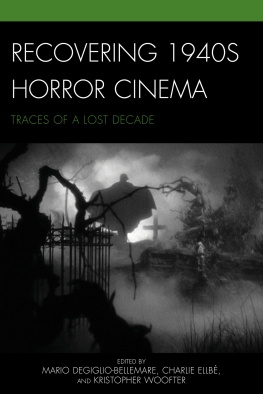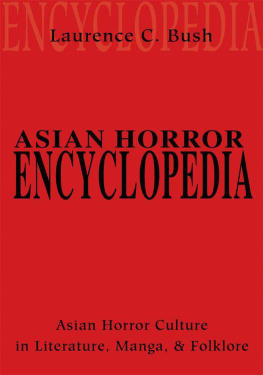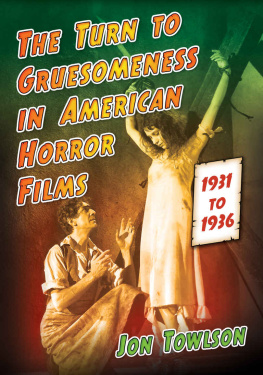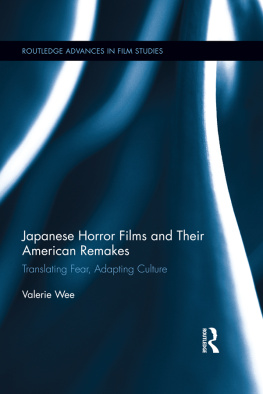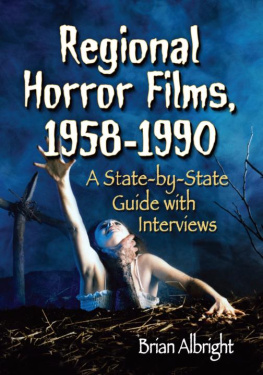Grateful thanks to those editors and film critics who have nurtured my writing assignments over the years or merely offered their wisdom and encouragement: Leslie Felperin, Ed Lawrenson, Philip French, Mark Kermode, Nick Bradshaw, Tom Charity, Nick Duncalf, Dan Etherington, Anne Billson, Jamie Graham, Michael Bonner, Anne Hudson and Hannah Patterson.
Eternal gratitude to my ever-supportive parents and sisters, and extra special thanks to my wife Maddy who eventually forgave me for taking her to see Audition, and to whom this book is lovingly dedicated.
Over the last decade, some of the sights and sounds of Asian horror have become so familiar to western audiences that they seem almost to have been reduced to a set of empty clichs and stock tricks: the haunted houses, creepy kids, ghosts in the machines, hands stretching from pools of brackish water, and, of course, all those lank-haired lady spooks, lurching jerkily towards the viewers throat. By the time this stuff ends up being parodied in an instalment of the Scary Movie franchise, it has inevitably lost some of its original potency.
But its easy to forget just what a potent shot in the arm for the horror genre the arrival of J-Horror was at the dawn of the millennium. Hideo Nakatas Ring a sensation on its release in Japan early in 1998 premiered in the UK at the 2000 Edinburgh Film Festival (paired with its sequel Ring 2) alongside Takashi Miikes equally revelatory Audition. These two films went on to gain substantial international acclaim, returning Japanese horror cinema to the spotlight for the first time since the 1960s. A new generation of directors embarked on a full-scale revival of several styles of Japanese horror that had been popular in earlier eras in particular the kaidan eiga (ghost-story film) that had flourished in the fifties and sixties while adventurous distributors began riding this J-Horror wave, helping transform Japanese horror from a modest, home-grown business into a lucrative international industry. Other Asian countries followed Japans lead, and new waves of horror were soon emerging from South Korea, Hong Kong and Thailand.
One of the benefits of the eastern horror boom has been to revive audience interest in some of the earlier landmarks of the genre; from cast-iron classics like Kenji Mizoguchis Tales of Ugetsu (1953) and Kaneto Shindos Onibaba (1964) to cult gems like Yasuzo Masumuras Blind Beast (1969), Asian horrors are now being appreciated afresh through lavish DVD reissues. This book is designed as an accessible overview of Asian horror cinema, highlighting some of the best examples of the genre from the 1950s to the present day. As well as exploring the production contexts and cultural backgrounds of seminal works like Godzilla, Kwaidan, Ring, Ju-On: The Grudge, Audition, The Eye and A Tale of Two Sisters, it also seeks to draw attention to less familiar, but no less rewarding, films like Marebito, The Untold Story and Nang Nak. Rather than attempting to be an encyclopaedic resource, this book aims rather to encourage readers to embark on their own explorations of some of the intriguing byways of Asian horror, while hopefully enhancing their appreciation of films they have already encountered.
This book also seeks to clarify some of the complexities of the mutually sustaining relationship between western and eastern horror cinema. When the new wave of Asian horror first broke with Ring, the films briefly found a home in mainstream cinemas, putting some of Hollywoods output at the time to shame. The likes of Nakatas superb Dark Water (2002) and Chan-wook Parks disturbing Sympathy forMr Vengeance (2002) played in multiplexes alongside the exhausted antics of Freddyvs Jason (ironically directed by Asian migr Ronny Yu), making it clear which way the wind was blowing. Hollywood was quick to take note, forking out for the remake rights to Asian horrors that had already proven their strong appeal for modern audiences seeking new types of scares. Starting with Gore Verbinskis lucrative remake of Ring in 2002, global audiences have been bombarded with a steady stream of glossy re-toolings of Asian originals the majority of which have been serviceably scary but conspicuously inferior in execution to their sources. At the same time, many of the stylistic signatures of J-Horror (and its other Asian variants) were being cannibalised by Hollywood ghost films like fear dot com (2002), The Amityville Horror (2005) and The Exorcism of Emily Rose (2005).
Of course, some of these stylistic tics had appeared in American cinema (Adrian Lynes Jacobs Ladder [1990] and David Lynchs Twin Peaks: Fire Walk With Me [1992] had already served up some terrifying, hallucinatory, jump-cut spookery), and American horror cinema wasnt entirely bereft of its own ideas at the point when Ring materialised. The jokey self-referentiality of the 1990s Scream franchise may have subjected the conventions of the slasher flick to merciless mockery, but the stylish gravitas of David Finchers Se7en (1995) restored some of its sheen, while the phenomenal success of The Blair Witch Project (1999) proved that its own backwoods folklore could still provide grist for the US horror mill. As the millennium turned, American cinema also had a ghost boom of its own, with David Koepps neglected Richard Matheson adaptation Stir of Echoes (1999), M Night Shyamalans The Sixth Sense (1999) and Alejandro Amenabars The Others (2001) delivering subtle supernatural chills closer to the spirit of Val Lewton than George Romero. It made sense, then, that the audiences for these films would also prove receptive to Asian horror cinema with its venerable traditions of ghost stories and that Asian films would provide rich pickings for Hollywood remakes. With most filmmakers nowadays being highly international in their outlook and interests, the ebb and flow of influence and counter-influence can be tough to trace. In an intriguing recent instance of cross-cultural synergy, Jason Cuadrados 2007 ghost anthology film Tales from the Dead was devised as a Japanese-language, J-Horror film which bizarrely was shot entirely in Los Angeles using local Japanese talent!
Despite all the cross-pollination between eastern and western horror in recent years, its clear that Asian horror films have characteristics that differentiate them from their western counterparts. These vary greatly between subgenres and regions, but in general involve a more fatalistic tone, a more pessimistic approach to an individuals control over their destiny, a more profound sense of the presence of supernatural forces in the real world, and a willingness allied with a lack of squeamishness to push horrific imagery to graphic extremes. As this book will hopefully demonstrate, these qualities have their origins in complex Asian cultural traditions, while the films frequently explore themes that are specifically rooted in the turbulent histories of the countries that created them.
Inevitably, Japan dominates any discussion of Asian horror cinema, and the bulk of the cultural background explored in this book relates to that country. However, South Korea, Thailand and Hong Kong have all been important sources of horror cinema in recent years, and separate chapters deal with their specific cultures. This book focuses on the East Asian countries that have experienced the most significant horror booms in recent years, to the exclusion of India, Malaysia, Singapore, the Philippines and other Asian territories whose horror films while being of considerable interest have not matched the international impact of East Asian horror.

